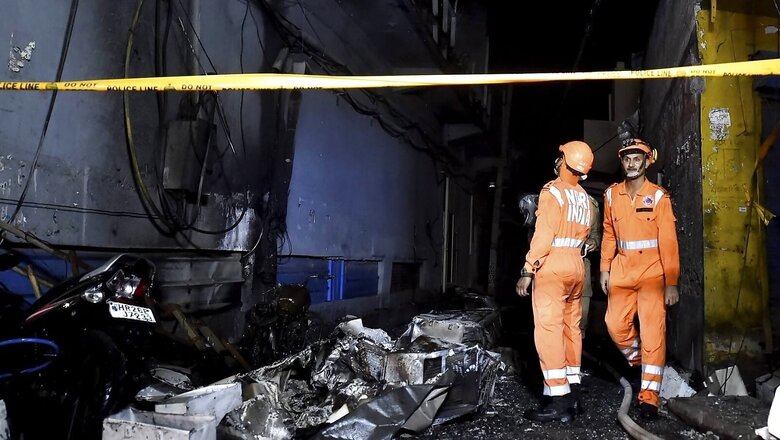
views
Tragedies continue to unfold in Delhi’s Mundka, after a horrific blaze in a multistoried commercial building killed 27 people and injured 12 others. Authorities say the death toll is likely to go up, even as distraught family members search for their missing relatives.
The stories that are now coming to light – people jumping from the building to escape – are mortifying. But they are sadly not new. India has seen its fair share of terrible fire disasters, with a commonality – unmet fire safety regulations and permissions. Search operations continue at the building, which contained mainly shops.
Atul Garg, director of Delhi Fire Services (DFS) told the Associated Press the building had no clearance from the fire department and it was not equipped with fire safety equipment like extinguishers. The casualties occurred on the second floor of the building, where inflammable plastic material used for manufacturing equipment like security cameras was stored. It has now been reported that two owners of a company selling security cameras have been arrested as the fire reportedly started from their office.
While elaborate fire safety regulations exist for multistoried buildings, reports regularly highlight how there is a lack of implementation on ground, with fire safety audits for even various hospitals in major cities are not taken seriously.
An earlier report by the Economic and Political Weekly elucidates upon this problem. Buildings and other infrastructure projects, many of which are unlawful, are erected without regard for fire safety, leaving firefighters unable to reach the impacted areas, it contends. The Kamala Mills fire in Mumbai in 2017 demonstrates this issue, the report states: unregulated development has resulted in cities spreading vertically, making it more difficult for firemen to extinguish flames on higher floors.
And basic in-building fire systems such as sprinklers and alarms are still missing. Bureaucratic dysfunction in fire safety is also a severe concern – only establishments with fire safety licences can be inspected for compliance with safety standards, while the others appear to be ignored, it sums up.
A Look at Basic Fire Safety Measures
In the wake of the tragedy, it remains essential to take a refresher of what basic safety norms look like for such buildings.
One of the most basic guidelines of fire safety is to have enough escape routes out of the structure, in proportion to its size and occupancy. The National Building Code (NBC) 2005, a precise set of principles for designing, maintaining, and operating buildings of all types, specifies the number, size, and position of exits. In order to be effective in an emergency, office occupiers must also ensure that stairwells, stairwells, and hallways are well-maintained, ventilated, and clear of impediments, the Mint reports.
It’s just as crucial to get to exits as it is to have adequate exits. The maximum distance a person must travel to reach a fire escape is specified by NBC requirements, as is the need of photo-luminescent signage for nighttime evacuation. When individuals are urged to leave the building in stages, refuge zones such as terraces are vital, the report further explains.
A fire’s first few minutes are critical for containing it. Automatic fire alarm systems, such as smoke and heat detectors should also be made vitally available.
Another important save: Interior materials. Workstations are particularly flammable due to the combination of wood, paper, and fabrics. Fabrics, on the other hand, can be made flame-retardant such that they self-extinguish when lighted. According to research from Indian office furniture producer BP Ergo, as cited in the report, a rising number of organisations, particularly multinationals, are requesting such materials despite their higher cost. Fire rules in other countries require US furniture companies like Herman Miller to use only fire-tested textiles.
Keeping the building accessible to firefighters, having building plans handy (to help rescue operations), and asking the local fire brigade to assess safety for a nominal fee should also be done. Fire safety drills should also done on a regular basis. Hazardous or combustible goods in storage, outdated and unstable structures, insufficient escape routes, or electricity overloads are all potential death traps that should be assessed by professionals.
No Accountability?
Smita Chakraburtty in a report for the Economic and Political Weekly, talked about weak laws and absent accountability in the system amid such disasters. She was writing after the Calcutta High Court scaled down charges against one of the prime accused in the AMRI hospital fire tragedy, which occurred in 2011 and killed a whopping 92 patients.
While the hospital’s managing director and other corporate employees were charged, Chakraburtty claimed that the accusations were watered down, and that the Indian Penal Code is limited in terms of holding corporate executives accountable.
To be found guilty of culpable murder, the law needs either factual proof beyond a reasonable doubt or direct involvement of the management top brass in the activity that caused the death. As a result, there is an urgent need for legislation that establishes vicarious accountability for senior management in cases of company operational failures that result in deaths, she contented. “Cases like this show how easy it is to raise the bogey of middle management blunders to escape the liability of graver charges in instances of mass murders which result from corporate greed,” she wrote.
Read all the Latest India News here

















Comments
0 comment